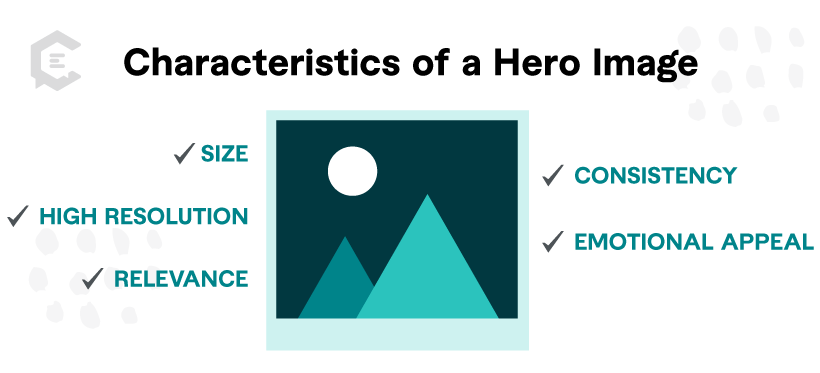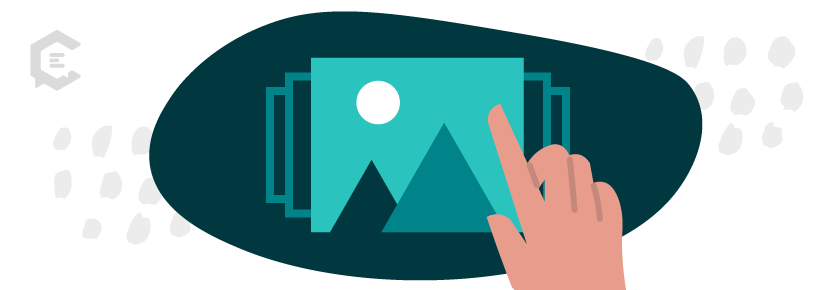What is a hero image?
A hero image is a large, visually striking graphic placed at the top of a website (the hero spot) or other designed page. In web design, the hero image is typically an oversized banner that extends across the screen. Its purpose is to catch people’s attention and convey the central message or theme of the content.

Characteristics of a hero image include:
- Size: It covers a significant portion of the screen or page
- High resolution: To ensure the image looks appealing and professional
- Relevance: The image is connected to the content or topic
- Emotional appeal: They evoke emotions that resonate
- Consistent: They align with the brand’s visual identity and style
Hero images play a crucial role in content marketing by capturing the audience’s attention and piquing their interest. That leads to increased engagement and improved conversion rates. They are instrumental in promoting products, services, events, or any other content that requires a strong visual impact to make a lasting impression.
Why are hero images so important?
The internet is saturated with an overwhelming amount of visual stimuli. The most valuable content in the world won’t mean anything if no one reads it. And the visual expression of your content is as important as the content itself in making that happen.
A hero image is usually the first thing visitors see when they land on your website or landing page. Its large size and visually captivating nature immediately draw their attention, making a strong first impression. The hero image is often a visitor’s first experience of who you are as a brand before they engage with any of your products or services.
Hero images are also capable of evoking strong emotions in your audience. Emotionally compelling images deepen a connection to your brand, making users more likely to engage with your content.
What type of company, product, or story can the hero image introduce?
Almost all of them, although not every designer feels they’re appropriate. But it’s much harder to find a site that doesn’t use hero images due to how effectively they create a connection.
Hero images introduce:
- Online publications of all types, from news to entertainment to sports
- Product websites — from surfwear to software
- New movies, shows, or album promotion
- Hospitality/hotel sites
- Event websites
- Lifestyle blogs
- Creative agencies and consultants
Are hero spots only on a web homepage?
No. Although it usually refers to the homepage banner, the term actually predates the internet. Print designers used it to describe the dominant, tone-setting graphic in a print ad or the first page of a feature.
When the term “hero image” is used elsewhere besides home pages, it takes on a slightly different meaning. For example, when many brands and influencers use photo carousels on Instagram, the “hero shot” is the leading image that shows the product front and center.
Do hero spots have to be photographs?
Definitely not! The hero image can also be a non-photographic graphic or a mix of photos with other elements. As a rule, the more complex the product or service, the more carefully hero image elements should be considered.
For a luxurious boutique hotel in the Caribbean, the hero image can be a property photograph. No words are needed. The photo alone can trigger a whole cascade of emotions:
- Appreciation of beauty
- A memory of a happy time
- The feeling of sunshine
- The impulse to escape
For a creative service provider looking to bring in clients, the hero shot would convey the firm’s philosophy, storytelling approach, or creative POV.
For a software company that provides enterprise B2B solutions, the hero image introducing a new product may be comprised of a simple graphic (representing a smartphone screen) with animated sample screens and text popups to illustrate how the product works — plus the product name, tag line, and value proposition.
The hero slider
For the many of you who feel like your company or product story can’t be told in a single image, the hero slider is your best friend. Essentially, you get a certain number of hero images to rotate into that hero spot, transitioning every few seconds.
But, the topic of the slider is polarizing among marketers and design professionals. Many think a hero slider (rotating carousel) doesn’t grab focus as effectively as a single hero shot. There are studies to support both sides of the argument, and ultimately, you will have to determine what works best for your company through A/B testing and tracking conversion.
If you want to get high-quality content to complement your hero images, talk to a content specialist at ClearVoice today. From engaging home page copy to informative blog posts, our managed content creation team has you covered.





